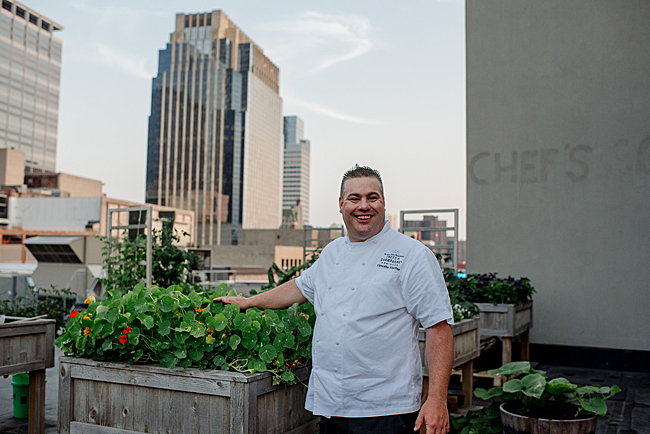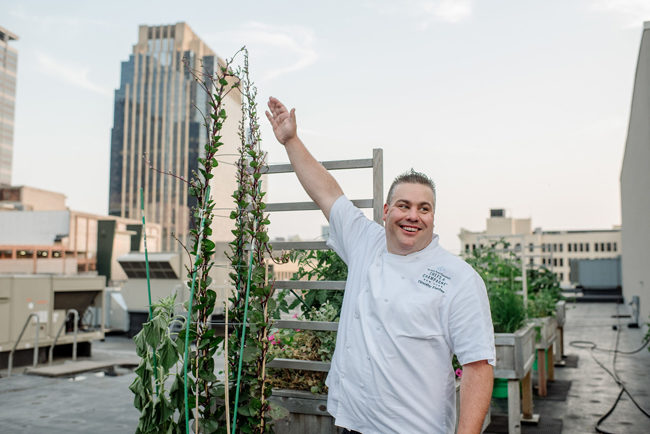
As we travel through the seemingly infinite and almost completely forgettable network of midmarket and business-class hotel chains that dot this country, it can be easy to forget that hotels were the original purveyors of fine food in the United States. Places like the legendary Waldorf Hotel in New York City, presided over by the tyrannical but brilliant Claudius Charles Philippe in the 1940s and ’50s, were gateways to a bigger, better, bolder world of eating and drinking. They forever changed the American landscape for the better.
But at their worst, modern hotel restaurants bring none of that vibrance. They can feel like upscale interpretations of fast food — $25 entrees, sure, but made with packet sauces, assembly-line cooking, and trends that are years behind the curve. It’s how you end up eating fabulous-looking but mediocre sushi in Nashville or forgettable scallops almondine in Spokane without really wanting to, and overpaying for the privilege.
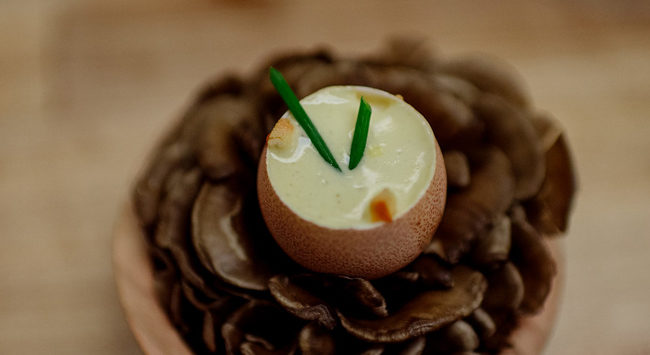
But you can still find hotels presided over by the likes of Chef Timothy Fischer of Loews Minneapolis. This is a “came in a skeptic, left a believer” story. Fischer and his team invited a few food writers (including me) for a foraged dinner a couple of months ago, and it left a vivid impression. The dinner was as lovely and manicured as anything we’ve seen, but it was powered primarily by ingredients with local pedigrees: greens from the hotel’s rooftop garden, Minnesota crayfish, foraged mushrooms. It was cosmopolitan food with a local flavor.
Fischer is a double threat — a seriously trained professional chef (he was James Beard-nominated in 2011,during his time at the Hotel Donaldson in North Dakota), and an outdoorsman who hunts, fishes, and forages. He constantly works to make connections between the land and the plates of food he serves to his guests.
At the Heavy Table, we are constantly trying to define Upper Midwestern food, and the common element we keep discovering is a love of grappling with ingredients at the most basic level: the carrot just pulled from the ground, the intact carcass ready to be broken down, the honey emerging from the hive, the herbs torn and sprinkled by hand. It’s an intimacy that makes for simple but unforgettable dishes, and it’s an attitude that Fischer displayed in spades, both at his dinner and at a follow-up interview conducted later, over a brilliantly simple breakfast of a wild mushroom omelet and a fresh salad largely plucked from the Loews Hotel rooftop chef’s garden.

CHEF TIMOTHY FISCHER ON GROWING UP
I grew up in St. Paul right over by Hamline College, so we were always going over to the fairgrounds and looking at the tractors and all that stuff.
When I was about eight, my parents moved up to Brainerd. I’d always been doing pickling and canning, but my first real jump into food was working at the Grand View Lodge. I started working when I was 14. I was roasting bones when I was 14 years old; we got to do that stuff there.
It was pretty amazing. Two of my partners from that summer went to the CIA [Culinary Institute of America]. One of them works at Pillsbury now, and one of them runs Fireside [Restaurant] up in DL [Detroit Lakes]. … If it wasn’t for [Grand View’s executive chef], I don’t know if the three of us would have made it to the CIA.
If you look at what Tim McKee has done, it’s similar. Hundreds and hundreds of people who went through — maybe they didn’t enjoy working at La Belle Vie when they were there, but they brought something out of the experience. If you have four or five great chefs in an area — the Lenny Russos, or the Tims [McKee] — we got pretty lucky in this area. It’s amazing what one person can do for a city, or a state.
It’s a fun game to get into. I’ve always done it because I’ve been a hunter and a fisher my whole life. The canning and pickling and preserving — it’s kind of ingrained into me from my grandmother and my mother. We always did that. The cheese guy and the smoked fish guy [at the St. Paul Farmers Market] — those were always my two favorite places to go.
I remember my father going into the little produce market up the hill there and buying truckloads of apples and cucumbers and tomatoes. Pulling the skins off of the tomatoes and peaches was always my favorite. Or stuffing the pickles into the jars. A lot of people don’t see that stuff. When we went to New York and New Jersey, 90 percent of kids thought food just came from the supermarket.
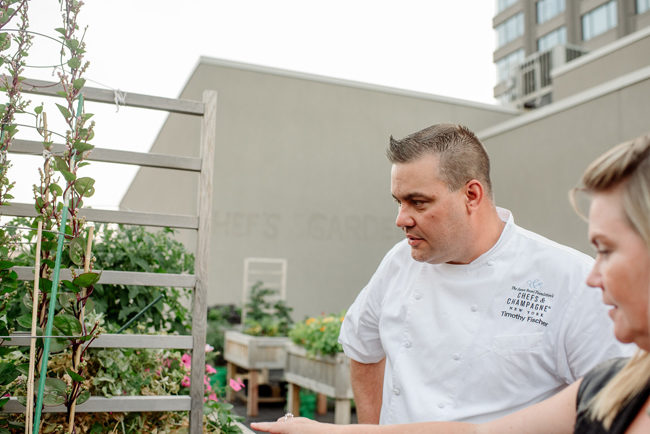
ON GETTING CLOSE TO YOUR INGREDIENTS
“Organic” on the sticker doesn’t necessarily mean anything. If you’re a chef who goes out and about and actually looks to see where food comes from, just look at the Amish lady who’s growing your produce, and she’s having a piece of pie with the best crust ever and she says: “Oh, that’s Barney! That was our pig from last year. We took all his fat, and that’s our pie crust.” If you know where your stuff comes from, it just pays off so much more in the end. You get these great ingredients that just shout out from the plate.
I live in Forest Lake, and between here and there, there are millions of mushrooms, and farms, and all kinds of different meats you can procure, and bison, and elk. … there’s so much stuff. [By contrast,] when I first got to North Dakota, I was looking around and asking, “What’s going on here?” We were surrounded by millions of acres of farmland, and everyone was farming, but nobody was farming food.

ON MUSHROOM FORAGING, WHICH HE DOES OFTEN AND EXTENSIVELY
The guys that use our chanterelles wouldn’t use chanterelles from anybody else. I don’t sell mushrooms that are more than three days old. I don’t grade mushrooms; I just do A’s and leave the rest for powder.
I want to provide my restaurant with the best mushrooms and provide a couple of the chefs in town here with the best mushrooms we can get. I do all kinds of stuff with Bardo and Paul over at Bachelor [Farmer]. Last year we did all kinds of business with him. This year I’ve been sending a lot of stuff to Utah because there are no mushrooms in the desert.
I’ve picked mushrooms in Virginia. I’ve picked mushrooms in New York, in Cape Cod, Chicago. I’ve picked mushrooms in Colorado. Last week I got a call from a guy in Louisiana because the chanterelles were going crazy and he picked hundreds of pounds in an hour. When a region is ready to rock, it’s ready to rock.
You look at your morels out there, and the soil temperature. When it gets to be spring, everybody’s out there with a thermometer on them, and if you’re into it, you’re testing the hillside; you’re looking at the dirt; you’re making sure you have the right amount of trees per square mile so you’re not wasting your time. … It’s about a 10-day period, unless it’s extended by the weather, and it hangs between 50 and 68 for a couple weeks. Then this part of the ground heats up, then the middle heats up, then the slope heats up, then the other side of the slope. …
A lot of people don’t think about preserving the mushrooms after they harvest them, too. Last year I didn’t run out of morels until the [next] season started. I had enough stockpiled and ready to go in the back.
ON WORKING WITH A FORMER SOUS CHEF TO BREED AND RAISE PIGS NEAR BRAINERD
We’re working with six pigs to make our own “Kobe” pig, basically. It’ll be a Mangalica pig crossed with a Berkshire, so it’s three-quarters Mang and one-quarter Berkshire. People don’t understand what [the Mangalica] is. Farmers would get [one], and they’d say: What the fuck is this? It’s taking forever to grow, and it doesn’t do anything for me, and it’s eating a lot of feed. … Next thing you know, you’ve bought a few-thousand-dollars pig. They’ve been doing a few things with breeding and crossbreeding to make it grow faster, and it kind of takes away from what the pig is all about. I’m just playing with it because I want to have that redness in there. Right now, I’m half and half. I’m going to have the first one down here in a month or so.
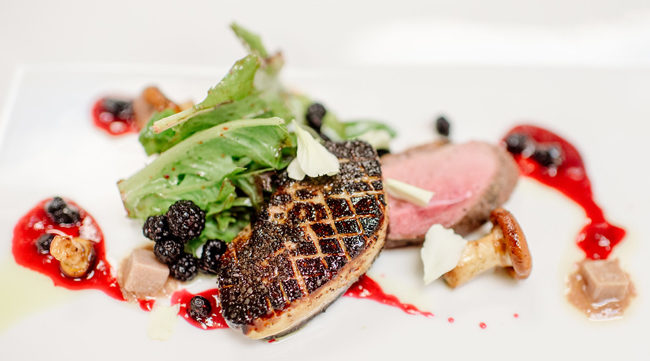
ON BEING DRIVEN BY FLAVOR, AND LETTING DINERS TAKE THE REINS AT THE CHEF’S TABLE
Last week we finished our lamb prosciutto. It was intensely amazing, with a little Moroccan spice on there. We did some old-school African preservation stuff. I say, “let’s make this,” and I’ve got five guys back there on Google. And that’s what really drives me. I want to serve Midwestern food, but I want to take the New York, the San Francisco, the everywhere else I’ve been in the world, and put it into our food, too.
I do what we call the Signature Chef’s Tasting. We offer that every night we’re open at Cosmos. It is just that: You’ll come and sit down, and I’ll come to the table and say, “What do you want?” And people will look at me and say: “What do you mean, ‘what do I want’? No chef has ever asked me what I want!”
And I’ll say: “Well, what kind of food do you like to eat? Is there something you wouldn’t want to try? Is there something you’d like to try: octopus, liver? … There’s so many things we can throw down.”
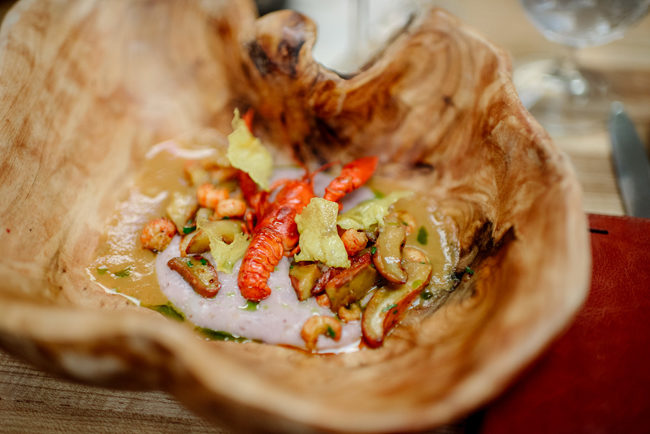
Minnesota foie gras, we can make sausage. … If you have a bunch of stuff back there, and you’re showing the team, “Hey, this is what I want,” things like that happen, and people keep in the groove. The menu is like a recipe — a recipe is just a guideline.
I remember in the ’80s and ’90s in New York, if you try to sub something, the chef would say, “See you later; I don’t want you in my restaurant.” That changed a lot. I took advantage of that right off the bat, and said, “Whatever you want.” It’ll be a couple minutes for your first course, but after that we’ll be rolling, and all the guys and gals back there will be running around finding stuff to make for you that molds around your personal taste, and giving them to you in a different light. That could mean taking the flavors of the Midwest and connecting them with, for example, your San Francisco palate.
We did a dish for a Finnish food writer — a foie gras and quail eggs Benedict, where the the foie was the toast and truffle stood in for the ham, and then I got a picture of it in this wonderful magazine, and I can’t read a word of this magazine somebody sent me from Finland, and I just thought that that was quite amazing, because that was one of those dinners where I asked, “What do you want me to do?” And they said, “You can do whatever you want for me!” and we just started making food back there. And that particular dish was cooked just once.
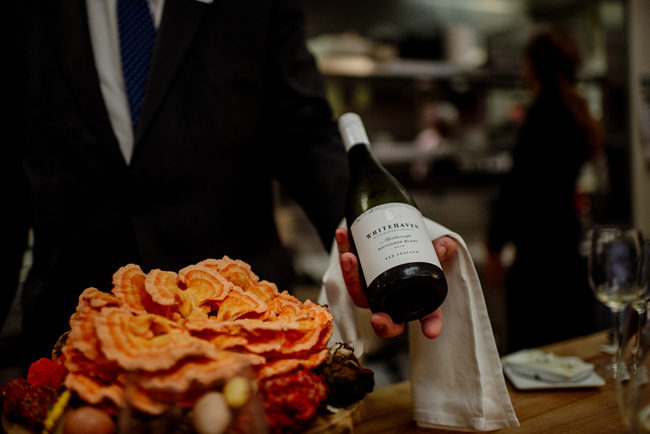
ON BRINGING WILDLIFE (AND THE CHEF’S LIFE) HOME TO HIS FAMILY
My son is 13, and he knows 60 or 70 wild edibles. He’s caught every single fish in the lake — sturgeons, northerns, muskies. He’s shot whitetails and ducks. He’s done more at 13 than I did at 19. It’s not that we’re doomsday preppers, but I say, ‘You know what, buddy, if we’re ever stuck in Alaska, it’d be you and I and my wife, and we’d be just fine.” … If you’re out in the middle of nowhere and the plane crashes, I want to be the guy that’s helping people out.
The whole northern forager thing came about because, you’re getting these terrible mushrooms that are said to be from Minnesota, but you know they’re from Washington, and one chanterelle from Minnesota in there and the rest of them are crap, all off-color. … I want my chanterelles to look like that egg yolk that comes from the farm. [I said to] my wife four years ago, “Hey, we’ve been married a long time, what do you want to do for our anniversary?” She said, “Teach me how to forage!” And I was like …”I love you!” We started foraging, and the first day we went out we got 86 pounds of mushrooms.
I make a fish batter out of mushroom flour, I do all this stuff at home. … The wild rice that we harvest off the dock: I got the kid and the wife in the living room dancing on the rice. You dry it out on a campfire, then these two are dancing on it in the living room … and I’m laughing my ass off — this is great! We only got a few dinners of rice out of it, but it was our dinner.
With our team, we go to mushroom farms; we go foraging – and the people who come up [leave] with a new sense of “What does a chef do, what should a good line chef do, and what should we know?” Then when we get back here, they’re not throwing the chanterelles on the floor; they’re not cutting too much fat off the duck breast — they’re rendering it. They’re pushing through to the next level.
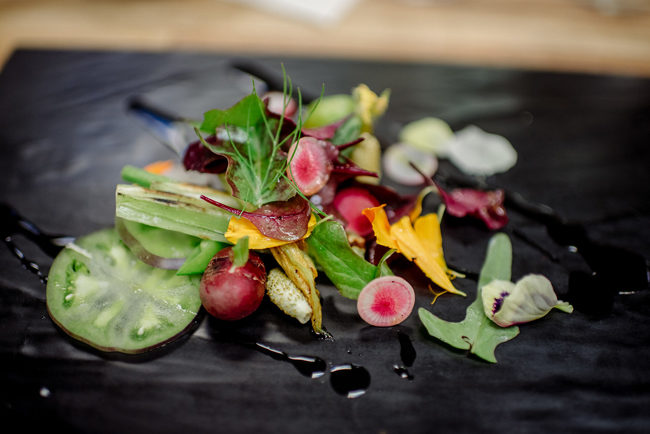
ON DETOURING FROM A WORK TRIP TO MADISON TO VISIT CHARLIE TROTTER IN CHICAGO
I’d brought along my sous chef [to Madison], and I said, “We’re real close to Chicago.” And he said, “What does that mean?” And I said, “Have you ever heard of Charlie Trotter?” And he went pale in the face and said, “Are you kidding me, chef?” And I said: “No I’m not; he’s a friend of mine. We’re going to call him up and drive from Madison and see Charlie.”
So I called up, and they said, “Oh, we’re full tonight.” About ten minutes later, the phone rings, and it’s Jennifer, and she says: “Hey, Charlie’s in Oaxaca right now; he’s on his way back. He’s not going to be back until 11. He’d like to invite you in for our chef’s table.” I was like, “No problem!” My guy was looking at me, and I said, “You want to drive to Chicago?” [Here Fischer makes a sharp intake of air indicative of pure excitement.]
So we had this huge dinner. And you’ve got the guys back there — one guy is just polishing copper, one person is crisping garnish, one person is doing veal, and we look around, and they’re all under the 30-year mark — a bunch of young culinarians. He wasn’t there, but he was there. We get through it. I think we had 30 courses, or something like that.
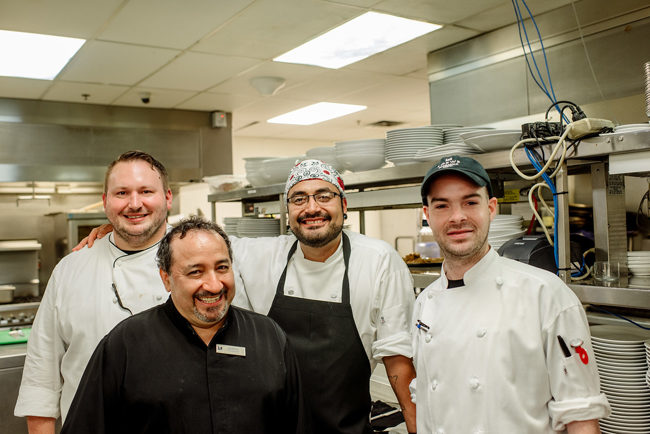
ON SIMPLICITY
I’ll never forget the carrot soup I had at the new Daniel [Boulud], the big one. It was just a little demitasse of carrot soup, but I drank a little bit, and I was like, “Damn, how the hell did he do that?” It was like he juiced a whole field into that soup.
That’s what I try to produce with my guys. When you first get out of school you throw 30 things on a plate. That’s cool, you know. … Everybody throws a lot of stuff on there. But as you get older, you start taking away a few of those things.
It’s all about flavor. That carrot is the best carrot you can get, that leek is the best leek you can get, so they’re singing back at the diners. That’s what the two- or three- or four- item dish is about. I did this one-item menu the other week for a tasting. We did one item for each dish. And the guys said, “What do you mean, one thing?” I was like, “I only want scallops on this dish.” And they said, “What are we going to put with the scallops?” And I was like ,”Nothin’. You’re just going to make the scallops. You’re going to make a little froth, you’re going to make a little chip, you’re going to make a little powder, and they’ll be three or four ways that scallop is going to be on the plate.” So these guys are back there twisting up ice creams, and chips so you have a scallop dish with nothing but scallops. And that’s one of the hardest things to do, to put just one or two things on a plate.
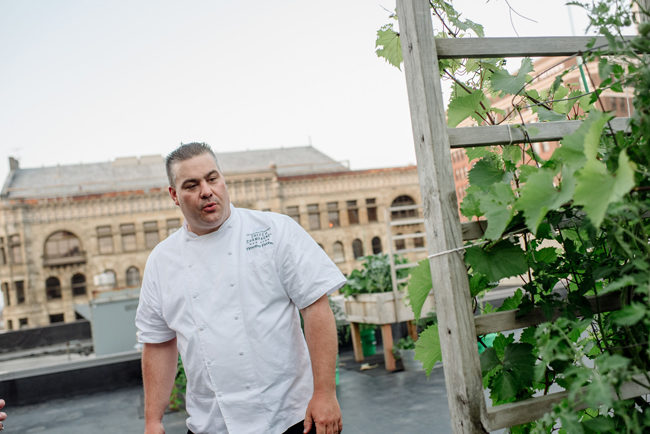
For me it’s seeing the guy punch in at 3 o’clock and saying, “Chef, can I get the key to the garden?” Sure can, you know. That’s the question I like to hear. I want my line cooks to enjoy the fact they can go up and take plants if they want. They can do whatever they want up there as long as it’ll bring good food back to the table.
Right before I left my property in New York to come to here I butchered the chickens. I had 75 people on staff. About five of them said they weren’t interested [in butchering] because it was medieval. About 65 [of the remaining 70] had never seen a chicken. And 70 of those 70 had never killed a chicken. And 70 of those 70 had never plucked a bird, eviscerated a bird, cooked it — all the way through. For me, that was a chance to change 70 people’s outlook. … We did that, and followed it through, and we made the best family meal I think they’d ever had, out of those chickens.

